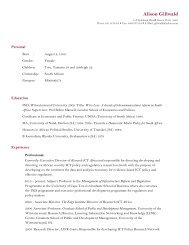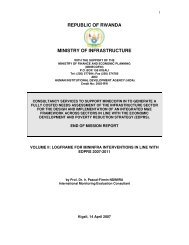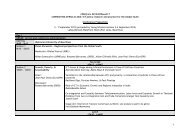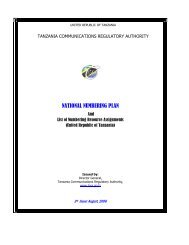Zambia ICT Sector Performance Review 2010 - Research ICT Africa
Zambia ICT Sector Performance Review 2010 - Research ICT Africa
Zambia ICT Sector Performance Review 2010 - Research ICT Africa
You also want an ePaper? Increase the reach of your titles
YUMPU automatically turns print PDFs into web optimized ePapers that Google loves.
<strong>Zambia</strong> <strong>ICT</strong> <strong>Sector</strong> <strong>Performance</strong> <strong>Review</strong> 2009/<strong>2010</strong><br />
5,000,000<br />
4,500,000<br />
4,000,000<br />
3,500,000<br />
3,000,000<br />
2,500,000<br />
2,000,000<br />
1,500,000<br />
Mobile<br />
Fixed<br />
Internet<br />
1,000,000<br />
500,000<br />
0<br />
2001 2002 2003 2004 2005 2006 2007 2008 2009<br />
Figure 4: Mobile, Fixed and Internet Customer Growth Trends<br />
The fixed-line network is highly skewed towards urban areas, which account for close to 90% of the<br />
PSTN subscribers, but only 55% of the country's population. The network is concentrated in Lusaka<br />
and Copperbelt areas, which account for around 50% and 30% of fixed lines, respectively, but less<br />
than 38% of the national population. The rural areas, with more than 60% of the population enjoy<br />
less than 10% of the fixed lines available. At present, the active fixed lines in <strong>Zambia</strong> are evenly<br />
distributed between commercial and residential subscribers.<br />
More than 80% of ZAMTEL's transmission network is digital. A number of microwave trunk routes<br />
carry traffic to major provincial centers. A digital optic-fiber backbone linking Lusaka and<br />
Livingstone is being installed as part of ZAMTEL’s network upgrade. Traffic to medium-sized towns<br />
and rural areas is carried via microwave links that also provide interconnection with neighboring<br />
countries where applicable.<br />
Chinese equipment supplier Huawei has been building the company a fibre backbone, but it is far<br />
from complete. Financing constraints have delayed completion of the project considerably.<br />
In spite of its monopoly status, as at end of 2009 ZAMTEL had fewer than 100,000 fixed and fixedwireless<br />
subscribers over the last 40 years and, since 2006, it has lost over 10,000 subscribers. While<br />
the two major private operators, namely Zain and MTN, had over 3.5 mobile million subscribers<br />
between them, Zamtel has fewer than 200,000 mobile customers. In 2008, Zamtel registered a ratio<br />
of 110 subscribers per employee compared to 586 – the average subscriber base per employee for<br />
sub-Saharan <strong>Africa</strong>n telecommunication operators.<br />
Zamtel’s bloated cost base, largely because of its large headcount, has led it to insolvency. In order<br />
to save the company from liquidation, the government opted to privatise Zamtel (see below).<br />
The fixed-line network<br />
is highly skewed<br />
towards urban areas,<br />
which account for<br />
close to 90% of the<br />
PSTN subscribers, but<br />
only 55% of the<br />
country's population.<br />
Zamtel’s bloated cost<br />
base, largely because<br />
of its large headcount,<br />
has led it to insolvency.<br />
Privatisation of Zamtel<br />
The Government has recognised that the <strong>ICT</strong> sector in <strong>Zambia</strong> has the potential to make significant<br />
contributions to economic growth. As a result, it has resolved to fully liberalise the<br />
telecommunications sector and is taking further steps to promote <strong>Zambia</strong>'s international<br />
competitiveness by removing barriers to doing business as part of the private sector development<br />
reform programme. These actions include eliminating Zamtel’s monopoly on the PSTN and<br />
international gateway as well as reducing license fees to regional averages.<br />
In December 2008, the government announced its intention to partially privatise Zamtel through<br />
the sale of 51% to 75% shares in the company’s equity. The government intends to retain a<br />
minimum of 25% of Zamtel’s equity, and reserves the right to list some, or the entire stake on the<br />
Lusaka Stock Exchange.<br />
In a speech to Parliament in August 2009, the Minister of Communication and Transport revealed<br />
that Zamtel had an annual operational deficit of US$17 million, liabilities in excess of US$125 million<br />
In December 2008,<br />
the government<br />
announced its<br />
intention to partially<br />
privatise Zamtel<br />
through the sale of<br />
51% to 75% shares in<br />
the company’s equity.<br />
13
















